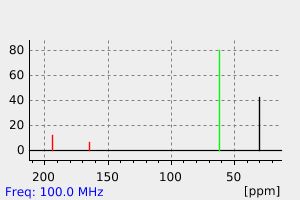sarcosine N-thiocarboxyanhydride | 59857-31-7
中文名称
——
中文别名
——
英文名称
sarcosine N-thiocarboxyanhydride
英文别名
3-methyl-1,3-thiazolidine-2,5-dione
CAS
59857-31-7
化学式
C4H5NO2S
mdl
——
分子量
131.155
InChiKey
AIFQYAOYRPTSID-UHFFFAOYSA-N
BEILSTEIN
——
EINECS
——
-
物化性质
-
计算性质
-
ADMET
-
安全信息
-
SDS
-
制备方法与用途
-
上下游信息
-
文献信息
-
表征谱图
-
同类化合物
-
相关功能分类
-
相关结构分类
计算性质
-
辛醇/水分配系数(LogP):0.3
-
重原子数:8
-
可旋转键数:0
-
环数:1.0
-
sp3杂化的碳原子比例:0.5
-
拓扑面积:62.7
-
氢给体数:0
-
氢受体数:3
反应信息
-
作为产物:参考文献:名称:Poly(ε-caprolactone)-block-polysarcosine by Ring-Opening Polymerization of Sarcosine N-Thiocarboxyanhydride: Synthesis and Thermoresponsive Self-Assembly摘要:利用氧胺端 PCL 引发的肌氨酸 N-硫代羧基酸酐开环聚合反应,合成了由聚肌氨酸(PSar)和聚(ε-己内酯)(PCL)组成的生物相容性两亲嵌段共聚物,并通过核磁共振、SEC 和 DSC 对其进行了表征。利用薄膜水合和纳米沉淀技术,详细研究了两种三嵌段共聚物 PSar8-b-PCL28-b-PSar8 (CS7)和 PSar16-b-PCL40-b-PSar16 (CS10)在稀溶液中自组装形成聚合物组的情况。通过对两种共聚物进行薄膜水合,获得了一些巨型囊泡,并通过激光共聚焦扫描显微镜进行了观察。在室温下通过纳米沉淀法获得了单层薄片和纳米纤维(厚度或直径为 8-10 nm),并通过冷冻电镜进行了观察。这些薄片和纤维结构在加热至 65 ℃(>Tm,PCL)后转变为蠕虫状圆柱体和球体(D ∼ 30-100 nm)。将 CS10 悬浮液加热至 90 °C,最终形成多胶束聚合体(D ∼ 100-500 nm)。聚合体的形成机制二是胶束通过水的扩散和亲水核的形成扩展成囊泡。细胞存活率测试证实自组装体没有细胞毒性。DOI:10.1021/acs.biomac.5b00930
文献信息
-
Polymersomes with aggregation-induced emission based on amphiphilic block copolypeptoids作者:Xinfeng Tao、Hui Chen、Sylvain Trépout、Jiayu Cen、Jun Ling、Min-Hui LiDOI:10.1039/c9cc07501a日期:——
Fluorescent and biocompatible polymersomes based on the amphiphilic block copolypeptoid P(TPE-NAG)-
b -PSar are promising for bio-imaging and drug delivery applications. -
Therapeutic Delivery of H<sub>2</sub>S via COS: Small Molecule and Polymeric Donors with Benign Byproducts作者:Chadwick R. Powell、Jeffrey C. Foster、Benjamin Okyere、Michelle H. Theus、John B. MatsonDOI:10.1021/jacs.6b07204日期:2016.10.19Carbonyl sulfide (COS) is a gas that may play important roles in mammalian and bacterial biology, but its study is limited by a lack of suitable donor molecules. We report here the use of N-thiocarboxyanhydrides (NTAs) as COS donors that release the gas in a sustained manner under biologically relevant conditions with innocuous peptide byproducts. Carbonic anhydrase converts COS into H2S, allowing NTAs to serve as either COS or H2S donors, depending on the availability of the enzyme. Analysis of the pseudo-first-order H2S release rate under biologically relevant conditions revealed a release half-life of 75 min for the small molecule NTA under investigation. A polynorbornene bearing pendant NTAs made by ring-opening metathesis polymerization was also synthesized to generate a polymeric COS/H2S donor. A half-life of 280 min was measured for the polymeric donor. Endothelial cell proliferation studies revealed an enhanced rate of proliferation for cells treated with the NTA over untreated controls.
-
Controlled Polymerization of N-Substituted Glycine <i>N</i>-Thiocarboxyanhydrides Initiated by Rare Earth Borohydrides toward Hydrophilic and Hydrophobic Polypeptoids作者:Xinfeng Tao、Yangwei Deng、Zhiquan Shen、Jun LingDOI:10.1021/ma501131t日期:2014.9.23N-substituted glycine N-thiocarboxyanhydrides (NTAs) are alternative monomers to prepare polypeptoids with large-scale producing potential compared to the corresponding N-carboxyanhydrides (NCAs) due to their easily synthetic approach and stability during purification and storage. Novel monomer N-butylglycine NTA (NBG-NTA) has been synthesized and well characterized for the first time. Rare earth borohydrides [RE(BH4)(3)(THF)(3), RE = Sc, Y, La, Nd, Dy, and Lit] have been first applied in the polymerization of sarcosine NTA (Sar-NTA) and NBG-NTA to achieve high molecular weight (MW) hydrophilic and hydrophobic polypeptoids. Polysarcosines (PSars), poly(N-butylglycine)s (PNBGs), and their copolymers with high yields, high MWs, and moderate MW distributions are synthesized at 60 degrees by using RE(BH4)(3)(THF)(3) initiators. MWs of polypeptoids are controlled by feed molar ratios. For instance, PSar with an absolute M-n, of 27.7 kDa (DP = 390) and PDI of 1.14 is produced successfully from Sar-NTA. Thermoresponsive random copolypeptoids poly(sarcosine-r-N-butylglycine)s [P(Sar-r-NBG)s] have reversible phase transitions (cloud point temperature) in aqueous solution and minimal cytotoxicity comparable to PEG and PSar, which is promising in various biomedical and biotechnological applications. Thermal properties of homo- and co-polypeptoids are investigated by TGA and DSC measurements.
表征谱图
-
氢谱1HNMR
-
质谱MS
-
碳谱13CNMR
-
红外IR
-
拉曼Raman
-
峰位数据
-
峰位匹配
-
表征信息
同类化合物
(甲基3-(二甲基氨基)-2-苯基-2H-azirene-2-羧酸乙酯)
(±)-盐酸氯吡格雷
(±)-丙酰肉碱氯化物
(d(CH2)51,Tyr(Me)2,Arg8)-血管加压素
(S)-(+)-α-氨基-4-羧基-2-甲基苯乙酸
(S)-阿拉考特盐酸盐
(S)-赖诺普利-d5钠
(S)-2-氨基-5-氧代己酸,氢溴酸盐
(S)-2-[[[(1R,2R)-2-[[[3,5-双(叔丁基)-2-羟基苯基]亚甲基]氨基]环己基]硫脲基]-N-苄基-N,3,3-三甲基丁酰胺
(S)-2-[3-[(1R,2R)-2-(二丙基氨基)环己基]硫脲基]-N-异丙基-3,3-二甲基丁酰胺
(S)-1-(4-氨基氧基乙酰胺基苄基)乙二胺四乙酸
(S)-1-[N-[3-苯基-1-[(苯基甲氧基)羰基]丙基]-L-丙氨酰基]-L-脯氨酸
(R)-乙基N-甲酰基-N-(1-苯乙基)甘氨酸
(R)-丙酰肉碱-d3氯化物
(R)-4-N-Cbz-哌嗪-2-甲酸甲酯
(R)-3-氨基-2-苄基丙酸盐酸盐
(R)-1-(3-溴-2-甲基-1-氧丙基)-L-脯氨酸
(N-[(苄氧基)羰基]丙氨酰-N〜5〜-(diaminomethylidene)鸟氨酸)
(6-氯-2-吲哚基甲基)乙酰氨基丙二酸二乙酯
(4R)-N-亚硝基噻唑烷-4-羧酸
(3R)-1-噻-4-氮杂螺[4.4]壬烷-3-羧酸
(3-硝基-1H-1,2,4-三唑-1-基)乙酸乙酯
(2S,4R)-Boc-4-环己基-吡咯烷-2-羧酸
(2S,3S,5S)-2-氨基-3-羟基-1,6-二苯己烷-5-N-氨基甲酰基-L-缬氨酸
(2S,3S)-3-((S)-1-((1-(4-氟苯基)-1H-1,2,3-三唑-4-基)-甲基氨基)-1-氧-3-(噻唑-4-基)丙-2-基氨基甲酰基)-环氧乙烷-2-羧酸
(2S)-2,6-二氨基-N-[4-(5-氟-1,3-苯并噻唑-2-基)-2-甲基苯基]己酰胺二盐酸盐
(2S)-2-氨基-N,3,3-三甲基-N-(苯甲基)丁酰胺
(2S)-2-氨基-3-甲基-N-2-吡啶基丁酰胺
(2S)-2-氨基-3,3-二甲基-N-(苯基甲基)丁酰胺,
(2S)-2-氨基-3,3-二甲基-N-2-吡啶基丁酰胺
(2S,4R)-1-((S)-2-氨基-3,3-二甲基丁酰基)-4-羟基-N-(4-(4-甲基噻唑-5-基)苄基)吡咯烷-2-甲酰胺盐酸盐
(2R,3'S)苯那普利叔丁基酯d5
(2R)-2-氨基-3,3-二甲基-N-(苯甲基)丁酰胺
(2-氯丙烯基)草酰氯
(1S,3S,5S)-2-Boc-2-氮杂双环[3.1.0]己烷-3-羧酸
(1R,5R,6R)-5-(1-乙基丙氧基)-7-氧杂双环[4.1.0]庚-3-烯-3-羧酸乙基酯
(1R,4R,5S,6R)-4-氨基-2-氧杂双环[3.1.0]己烷-4,6-二羧酸
齐特巴坦
齐德巴坦钠盐
齐墩果-12-烯-28-酸,2,3-二羟基-,苯基甲基酯,(2a,3a)-
齐墩果-12-烯-28-酸,2,3-二羟基-,羧基甲基酯,(2a,3b)-(9CI)
黄酮-8-乙酸二甲氨基乙基酯
黄荧菌素
黄体生成激素释放激素(1-6)
黄体生成激素释放激素 (1-5) 酰肼
黄体瑞林
麦醇溶蛋白
麦角硫因
麦芽聚糖六乙酸酯
麦根酸







